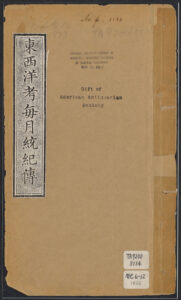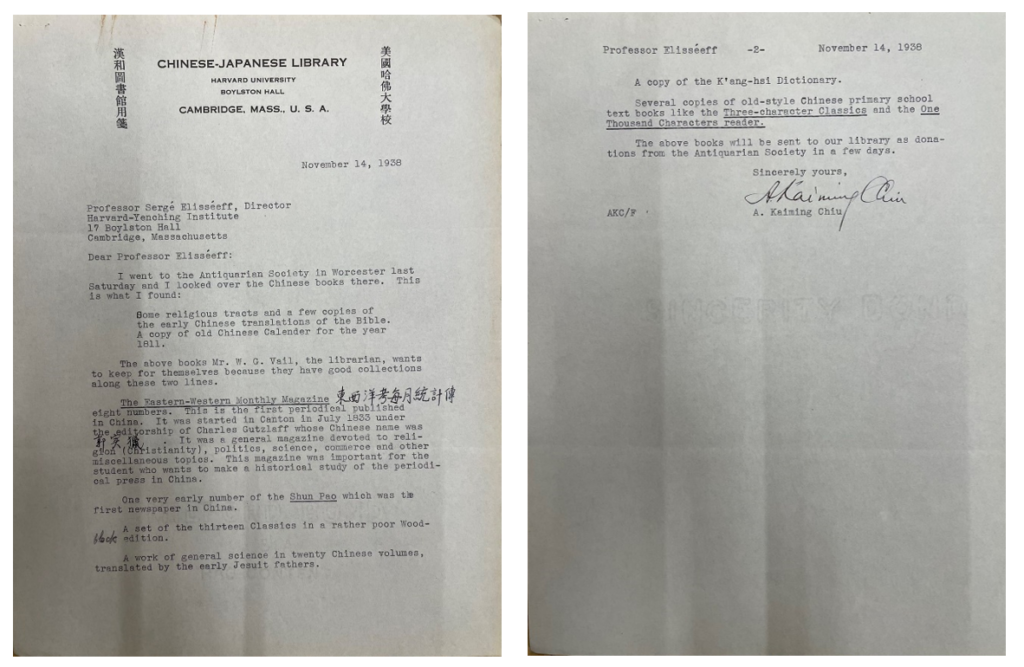
View in Harvard Library Viewer
Original images held by the Harvard-Yenching Library of the Harvard College Library, Harvard University
Summary written by Jie Li (Harvard-Yenching Library)
“Eastern Western Monthly Magazine”, compiled by missionary Karl Friedrich August Gutzlaff (郭實獵) and others, was the earliest modern periodical published in Chinese in China. It was first published in August 1833 (道光癸巳年六月) and ended in October 1838 (道光戊戌年九月). Although publication was interrupted twice in the year 1834 (道光甲午年) and 1835 (道光乙未年), and there was no publication in the year 1836 (道光丙申年), the publication resumed in February 1837 (道光丁酉年). It continued until October 1838 (道光戊戌年九月), a total of five years and three months. The magazine was founded in Guangzhou, moved to Singapore in 1837, and ceased publication in October 1838. Its publication and distribution processes were relatively complicated. During the publication period in Guangzhou, it was compiled by missionary 郭實獵 under his signature of 愛漢者. After relocating to Singapore, it was managed by The Society for the Diffusion of Useful Knowledge in China (中國益智會). The first issue of 600 copies sold out, so an additional 300 copies were printed to meet the high demand. During the magazine’s first three years of publication, it usually printed 500 monthly copies. The magazine was mainly distributed through two bookstores in Guangzhou, which had branches in big cities, so the magazine’s circulation expanded to Nanyang, Beijing, Nanjing, and other metro areas.
The Harvard-Yenching Library has the most complete existing “Eastern Western Monthly Magazine” with a total of 39 issues, but the contents of 6 of them are exactly the same. Others, such as the British Library, Yale University Library, and Cornell University Library, have incomplete volumes. The Harvard-Yenching Library acquired the magazine from the Worcester Antiquarian Society as a donation on November 21, 1938. According to the correspondence from Alfred Kai-ming Ch’iu, the director of the Harvard-Yenching Library with Serge Elisséeff, the director of the Harvard-Yenching Institute, Ch’iu described the magazine as “a general magazine devoted to religion (Christianity), politics, science, commerce, and other miscellaneous topics and it was important for the student who wants to make a historical study of the periodical press in China”[1].

Image 1-2: Letter of Alfred Kai-ming Ch’iu to Serge Elisséeff, November 14, 1938.
Although Gutzlaff 郭實獵 was a missionary, he was proficient in Chinese culture, had a deep understanding of Confucian classics, and had a passion for Chinese poetry. In order to attract the interest of the Chinese people in Western learning and to facilitate a better acceptance of Western knowledge and the publication itself, he consistently included Confucius and Mencius quotations on the cover of each issue during the magazine’s compilation. Not only once, but multiple times, he cited poems by famous Chinese poets such as Li Bai and Su Shi. As to the content, this magazine introduced various aspects of Western knowledge, including history, geography, science and technology, astronomy, economics, politics, law, and literature. Many of its contents were pioneered in China, exerting a widespread influence on the fields of journalism, publishing, and literature in the country. It played a significant role in the cultural exchange between China and the West, serving as a crucial window through which Chinese people could open up to and understand the world. It brought a fresh perspective to the Chinese people and contributed to broadening their worldview.
The magazine took a comparative global perspective to disseminate Western culture, prompting some progressive Chinese individuals to “open their eyes and see the world.” This led to the emergence of new works in the Chinese academic community, such as Wei Yuan’s “Hai guo tu zhi” 《海國圖志》, Liang Tingnan’s “Hai guo si shuo” 《海國四說》, and Xu Jishe’s “Ying huan zhi lue” 《瀛寰志略》. To some extent, their works were influenced by this magazine, with Wei Yuan being the most significantly impacted. He referenced this magazine 28 times and wrote 24 articles citing its content.[2]
[1] Harvard-Yenching Library files, 1928-1965 (哈佛燕京圖書館檔案, 1928-1965): Letter of Alfred Kai-ming Ch’iu to Serge Elisséeff, November 14, 1938.
[2] 爱漢者等编, 黃時鑑整理, 《東西洋考每月统记傳: [影印本]》, 北京: 中華書局, 1997, 導言, 第28頁.
